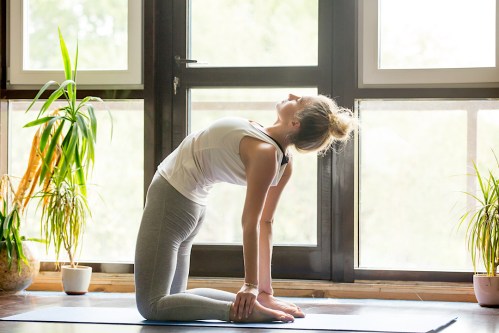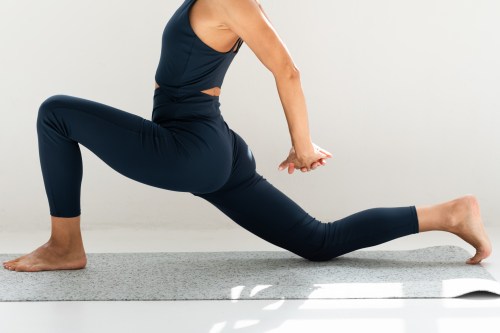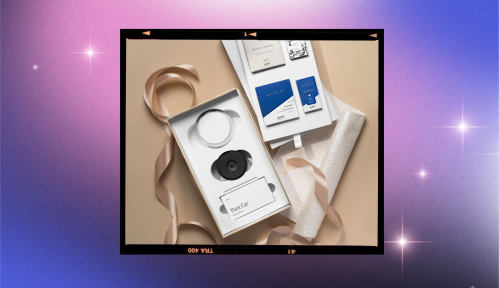Our editors independently select these products. Making a purchase through our links may earn Well+Good a commission
There’s no shortage of yoga poses that provide major benefits: downward dog, savasana, and cat-cow pose, to name a few. Another pose to add to your next yoga flow? Ustrasana, also known as camel pose. This heart-opening backbend feels as yummy as it looks, and it’s especially delicious after you’ve spent the day hunched over a desk or computer, says Sabrina Washington, a CorePower Yoga instructor in Sacramento, California. That makes it a great transition exercise as you get ready to unwind for the evening. Intrigued? Read on to hear more camel pose benefits, as well as step-by-step instructions on how to do it, and precautions to keep in mind.
Experts in This Article
Ustrasana or camel pose benefits
1. Stretches and strengthens
“Camel pose (ustrasana) stretches the front of the body (thighs, hip flexors, abdominal muscles, pectoral muscles, and shoulders) while strengthening the back of the body (glutes and hamstrings),” reveals yoga teacher Victoria Hutchins (aka The Daily Victorian on Instagram).
2. Corrects rounded shoulders
Many of us spend too much time slouched over something (computer screens, cell phones, steering wheels, etc.). “Unfortunately, our shoulders, upper back, spine, and neck suffer the consequences,” Washington says. “Camel pose counteracts this by literally opening up our chest and maneuvering our spine in the opposite direction to correct rounded shoulders, relieve pain that has accumulated in our necks and upper backs, and strengthen our spine.”
3. Helps with back pain
In addition to correcting rounded shoulders, this pose can also help prevent back pain. “Oftentimes, back pain can come from poor posture, which may be the result of a weak core or hunched upper body,” Washington says. “When done properly, camel pose engages the muscles in your back and abdominals, which can help prevent future issues.”
4. May relieve constipation
If you’ve gone a few days without pooping, you may want to add this pose to your yoga flow. “Yoga has been [shown] to help with digestion,” Washington says. “Camel pose, in particular, stretches your abdominals, stomach, and intestines, which are key to healthy digestion and relieving constipation.”
5. Opens up your chest
“Camel pose is a backbend that opens your heart chakra to giving and receiving joy, love, and compassion,” Washington says, adding that it can also make breathing easier because it increases your breathing capacity. With heart-opening poses like this, some people may feel vulnerable or emotional during or after the pose. Washington advises being gentle with yourself and taking it at your own pace if this happens.
6. Cultivates a sense of inner harmony
Overall, most people feel calm, empowered, and strong when doing Ustrasana. “Some people also find this pose very relaxing, which can decrease overall stress and anxiety levels to help create a sense of inner peace,” Washington says.
How to do the Ustrasana or camel pose
The key with the camel pose is not to overdo it with the backbend. “The priorities are to find a backbend that you do not want to run away from and to discover a shape where you can breathe deeply for about 30 seconds,” Washington says.
Start by kneeling at the center of your mat with your knees directly under your hips. Place your hands on your lower back with fingers pointing down toward the floor. As you inhale, lift your chest toward the ceiling, leading with your heart, to create a C-curve with your back. Take a moment here to check in on how this sensation feels. You can hold here for for 30 to 60 seconds. Or, take this pose deeper by engaging your thighs and glutes (this helps protect your lower back) and bring your hands onto your heels. Ensure your hips remain stacked over your knees and keep your chin pointed towards your chest. Hold the pose for 30 to 60 seconds.
To come out of the pose, place your hands back on your hips. Engage your abs as you slowly lift your chest back to an upright position. Lastly, with your hands on your thighs, take a few breaths to calm your heart rate and ground yourself if you feel disoriented.
Pro tip: “Always listen to your body, and make sure you take the time to safely exit the pose,” Washington says.
Camel pose tips for beginners
If you’re new to yoga and/or don’t consider yourself to be the most limber of the bunch, you may feel a bit intimidated by an advanced yoga position like the camel pose. Don’t worry! There are variations to help you work through it as you build up the strength, flexibility, and courage in yourself to bend backward and hold the pose.
“To give camel pose a try, begin by kneeling with your knees hip-width distance apart and hips vertically stacked over your knees; rest your hands at the base of your spine, with your fingers pointing downward, and slowly start to beam your heart towards the sky and lift your gaze, keeping the spine elongated, your core engaged, and your hips stacked over knees,” Hutchins says.
Instead of moving into a C-curve as Washington suggests, though, Hutchins says beginners can stay right there. “This alone is a great expression of camel pose and one I practice often,” she exclaims. “If you’d like to reach for your heels, I’d recommend that beginners tuck their toes to bring their heels a little closer to their hands. You can also place blocks on the outside of your heels and reach for those instead.” Additionally, she says that until you develop the stability and flexibility necessary for bending backward in unison, you can reach for one heel or block at a time.
Precautions and common mistakes
Skip it if you’re injured
While camel pose is a great move for most people, Washington advises skipping it if you’re injured, are recovering from surgery, or experienced chronic knee, shoulder, neck, or back pain. “This is an intermediate and more strenuous pose that can agitate preexisting muscle aches or joint issues in these areas,” she warns. “Be sure to speak with your doctor if you have any concerns before practicing yoga.”
Warm up first
Washington also notes that some people experience headaches after doing backbends. To prevent this from happening, she suggests adding a camel pose toward the end of a yoga sequence rather than at the beginning. “This way, our bodies are properly warmed up, stretched, and prepared for the opening,” she says. Or, at least do some cat-cow stretches to activate your abs and back first.
Keep breathing
Unintentionally holding your breath while leaning into the pose or holding a backbend may also lead to headaches. So, “use your breath as a guide for your movement,” Washington says. “For example, let your inhale create lift in your chest, and use your exhale to discover depth.” Again, the important thing with Ustrasana is not to overextend yourself. “Find a backbend where you can mindfully breathe throughout the duration of the pose.”
Be mindful of your gaze
It’s also important to be aware of where you’re looking. “Your gaze should most likely land towards the ceiling, not the back of the room,” Hutchins says. If you’re looking more toward the back of the room, you may be overextending your neck, which is a sign of misalignment, and could potentially neck and spinal pain.
Focus more on extending up, not back
It’s also possible to misalign your knees, hips, and spine. “Bearing the full brunt of the bend in your low back/lumbar spine is a very common mistake,” Hutchins reveals. “I also commonly see practitioners shift their hips behind their knees in order to reach the heels, which compromises the stretch.” To avoid these mistakes, she says to focus on your extending your heart upward—not backward. “[It will] keep the thoracic spine involved and the hips in alignment with the knees,” she points out.
Frequently asked questions
Why is camel pose difficult at first?
Remember: Camel pose is an intermediate pose—it’s not as easy as it may seem. According to Hutchins, the reason camel pose can be so difficult at first is due to its physical and emotional effect. “People tend to love or hate camel pose—in addition to being a physically intense pose, it also commonly leads to big emotional reactions and sometimes even dizziness or nausea,” she says. “We don’t commonly bend backwards in our day-to-day life, so to beginners, that may feel strange or even scary.”
Is camel pose bad for your knees?
In and of itself, camel post isn’t bad for your knees. Depending on your pre-existing conditions, though, it can be uncomfortable. “Everyone is different, but many people can safely practice Ustrasana,” Hutchins assures us. “If putting your weight on your knees is uncomfortable, it can be helpful to fold your mat to double up the support.” (Looking for a mat that folds especially easily? Check out the Stakt Mat, $68, which is segmented to fold easily, making it great for comfort.)
How long do you hold the camel pose in yoga?
Typically, camel pose is best held for 30 to 60 seconds. That said, the ideal duration of the pose is subjective, as it depends on your abilities and how you feel while holding the pose. “It depends on the practitioner and their preference, but I tend to hold it for three to five long, slow breaths,” Hutchins shares. “If you feel dizzy or nauseated, don’t hesitate to come out of the pose, even if you’re in a group setting and the rest of the class is still in it. Honoring your body and its limits is so important in this pose (and every pose).”
What is the spiritual meaning of the camel pose?
Spiritually, camel pose has the ability to trigger deep emotional release. “Ustra means camel in Sanskrit, and camel pose is named after the camel-hump shape the body makes in it,” Hutchins says. “Camel pose is a heart opener, which means it stimulates the heart chakra (anahata chakra). Many people practice heart openers to welcome in compassion, emotional openness, and vulnerability.”
Why we love this pose
Overall, camel pose bolsters growth and offers relief in two realms, physical and emotional. “I used to hate camel pose, but over the years it has become one of my favorite poses,” Hutchins admits. “I love the emotional benefits of practicing heart openers and how energized they make me feel.”
Practice your camel pose, along with other chest openers, in this 10-minute stretching video:
Sign Up for Our Daily Newsletter
Get all the latest in wellness, trends, food, fitness, beauty, and more delivered right to your inbox.
Got it, you've been added to our email list.











